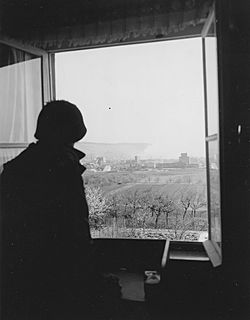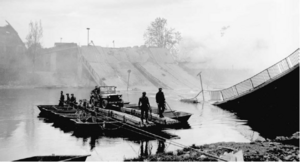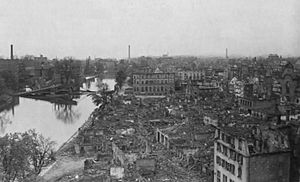Battle of Heilbronn (1945) facts for kids
Quick facts for kids Battle of Heilbronn |
|||||||
|---|---|---|---|---|---|---|---|
| Part of the Western Allied invasion of Germany in the Western Front of the European theatre of World War II | |||||||
 A 7th U.S. Army soldier of the 100th Division looks out of a building overlooking the German city of Heilbronn. 9 April, 1945. |
|||||||
|
|||||||
| Belligerents | |||||||
| Commanders and leaders | |||||||
| Withers A. Burress | Georg Bochmann | ||||||
| Units involved | |||||||
| 100th Infantry Division | 17th SS Panzergrenadier Division Volksturm units |
||||||
| Casualties and losses | |||||||
| 60 killed 250 wounded 112 missing Total 422 |
1,500 captured | ||||||
The Battle of Heilbronn was an important fight during World War II in April 1945. It lasted for nine days. This battle was fought between the United States Army and the German Army. They were fighting for control of Heilbronn, a city in Germany. Heilbronn is located on the Neckar River, between Stuttgart and Heidelberg.
Even though World War II was almost over in Europe, the German forces fought very hard. They had regular soldiers and also other groups like Nazi Party helpers. After many days of fighting from house to house, the U.S. 100th Infantry Division finally captured Heilbronn. After that, the U.S. VI Corps continued its advance to the southeast.
Contents
German Defenses in Heilbronn
The German army had strong defenses around Heilbronn. They used the Neckar River and another river called the Jagst as natural barriers. The German First Army had its strongest remaining division, the 17th SS Panzer Grenadier Division, defending this area.
Who Was Defending?
General Hermann Foertsch, the commander of the German First Army, gathered many different types of troops. These included:
- Two battalions from an engineer school.
- Several regular engineer battalions.
- Artillery and anti-aircraft units.
- The Volkssturm, which were local militia units made up of older men and boys.
- A few tanks and assault guns.
- Several hundred Hitler Youth members.
All these groups were under the command of General Bork's XIII Corps. Other German divisions were also nearby and could help defend Heilbronn if needed.
The U.S. Attack Begins
The U.S. attack started before dawn on April 4. Soldiers from the 3rd battalion of the 100th Division's 398th Infantry Regiment quietly crossed the Neckar River. They used small assault boats. They landed north of Heilbronn, near the suburb of Neckargartach.
Early Challenges for U.S. Troops
As the American soldiers moved south towards the city, German troops launched a surprise counterattack. Some Germans even used tunnels to appear behind the U.S. soldiers. This fierce fight pushed the Americans back close to the river. They managed to hold their position there.
Later that afternoon, another battalion of the 398th Regiment crossed the river under enemy fire. This helped the Americans start advancing again. However, they could only move about 1,000 yards (914 meters) into the city. This wasn't enough to stop German small arms fire from reaching the river crossing. Because of this, U.S. engineers could not build a bridge across the Neckar.
On the same day, General Burress, who led the 100th Division, ordered the 397th Infantry Regiment to cross the Neckar River just south of the 398th's position.
Fighting in the City
Three battalions of the 100th Division eventually crossed into the small area north of the city. They pushed south into a group of factories on the city's northern edge. The fighting was very slow and difficult. Since the crossing point was still under German fire, engineers still could not build a bridge.
Without close support from tanks or other vehicles, the infantry soldiers relied on artillery from the west bank of the Neckar. But it was hard to aim the artillery in the crowded factory area. The Germans were protected by strong buildings. They rarely gave up unless forced to at gunpoint. However, many of the Hitler Youth soldiers quickly surrendered after a short burst of resistance.
One U.S. soldier described the intense fighting: "House to house, room to room, over dead Krauts, through rubbish, under barbed wire, over fences, in the windows and out of doors, sweating, cussing, firing, throwing grenades, charging into blazing houses, shooting through floors and closet doors."
At one point, a group of Hitler Youth soldiers ran screaming into American lines to surrender because of heavy mortar fire. Their own officers shot at them to try and stop them.
Bridge Building Challenges
On the night of April 5, a battalion of the 397th Infantry crossed the Neckar south of Heilbronn. They found the German resistance just as strong there. Engineers almost finished a bridge on the afternoon of April 7. But then German artillery, guided by observers on the hills east of Heilbronn, started hitting the bridge.
The engineers finally succeeded early the next morning. However, only a small number of tanks and two platoons from the 824th Tank Destroyer Battalion could cross before German shells destroyed the bridge again. Two days later, a large pontoon ferry faced a similar problem. It transported only a few more tanks and tank destroyers before it was also knocked out.
On April 8, the U.S. 399th Infantry Regiment crossed the Neckar south of Heilbronn. They moved into the southern industrial areas and the village of Sontheim.
Heilbronn Captured
Most of Heilbronn was under U.S. control by April 9. But it took until April 12 to clear the city of all German fighters and build a stable bridge across the Neckar. On that day, the 397th Infantry captured two hilltops east of the city, known as "Tower Hill" and "Cloverleaf Hill." These actions, along with the general advance of all three U.S. regiments, marked the end of organized German resistance in Heilbronn.
Aftermath of the Battle
The Battle of Heilbronn lasted nine days. The U.S. 100th Division lost 85 soldiers killed and about three times that number wounded. During the battle, the 100th Division captured 1,500 German soldiers.
Meanwhile, the U.S. 63rd Division, helped by tanks from the 10th Armored Division, kept pushing against the German lines along the Jagst River. They hoped to trap the 17th SS Panzer Grenadier Division. Although U.S. armored forces finally met up with the 100th Division near Heilbronn on April 14, the German panzer grenadiers had already left the area.
Battle's Impact
General Foertsch's strong German defenses along the Jagst-Neckar rivers took eleven days of intense fighting to overcome. Despite the determined German resistance, American casualties were relatively low. The U.S. VI Corps lost about 230 soldiers per day on average. This number was almost double the casualties they had suffered during their advance to the rivers.
While the German defense delayed the U.S. VI Corps for almost two weeks, it did not stop the overall advance of the U.S. Army into southern Germany. Heilbronn itself was already heavily damaged by air raids before the battle. The house-to-house fighting during the nine-day battle likely caused even more damage to the city.
See also
- Battle of Buchhof and Stein am Kocher



